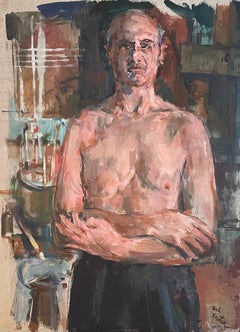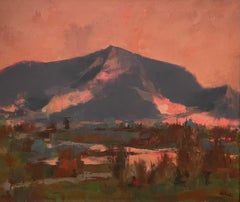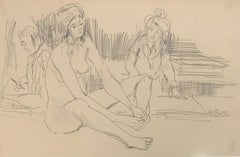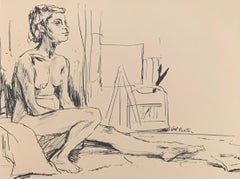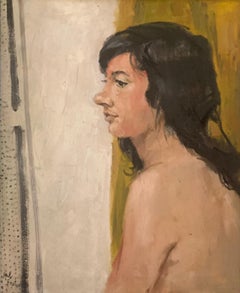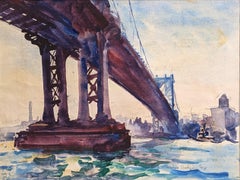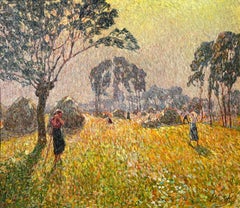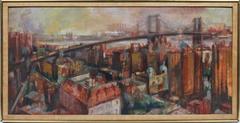Hal Frater Art
American, 1909-2008
Hal Frater: A Portrait of an Artist's Life
Hal Frater (1909-2008) was a prolific painter whose life and work spanned nearly a century, reflecting the dynamic changes in American art and society. Born in New York City, Frater's artistic journey began in the heart of a burgeoning art scene that would shape his creative path.
Frater's artistic style evolved over the years, reflecting the diverse influences and trends of the 20th century. Although specific details about his education and training are not widely documented, it is evident that his work was deeply rooted in the traditions of American painting, while also embracing the innovative spirit of his time.
Throughout his career, Frater exhibited remarkable versatility in his choice of subjects and mediums. His portfolio includes a wide range of paintings, from landscapes and portraits to abstract compositions. This versatility not only showcases his technical skill but also his ability to capture the essence of his subjects with sensitivity and depth.
Frater's contributions to the art world were recognized in his lifetime, with his works being showcased in various exhibitions. His legacy continues to be celebrated posthumously, as his art remains a testament to his talent and vision.
As we reflect on Hal Frater's life and work, we are reminded of the enduring power of art to capture the human experience and inspire future generations. His paintings serve as a window into the past, offering us a glimpse of the world through his eyes and inviting us to explore the depths of our creativity.(Biography provided by American Art Gallery)
to
5
7
5
2
5
2
3
3
1
Overall Height
to
Overall Width
to
5
6
5
4
3
2
2
1
1
1
1
1
1
1
7
1
1
7
6,952
3,301
2,514
1,213
7
7
7
7
1
Artist: Hal Frater
'The Artist as a Young Man' by Hal Frater - Ashcan School Figurative Painting
By Hal Frater
Located in Carmel, CA
Hal Frater's "The Artist as a Young Man" is a striking oil on canvas that captures the essence of the artist himself, rendered in a raw, emotive style. The palette is earthy, with na...
Category
1950s Ashcan School Hal Frater Art
Materials
Canvas, Oil
'Pink Sky' by Hal Frater - Mountain Range at Dusk - Oil Painting on Canvas
By Hal Frater
Located in Carmel, CA
Hal Frater's "Pink Sky" is a moody landscape that masterfully captures the play of light at dusk. Dominated by a majestic mountain under a vast, dusky sky, the painting is steeped in...
Category
1970s Ashcan School Hal Frater Art
Materials
Canvas, Oil
'Painters with a model' Original Drawing By Hal Frater
By Hal Frater
Located in Carmel, CA
Hal Frater passed away on February 3, 2008, just a month from celebrating his 99th birthday.
Hal Frater had a long and prolific career. He became a sought after commercial artist fo...
Category
20th Century Modern Hal Frater Art
Materials
Oil, Canvas
'Woman On Chair’ Original Drawing, Figurative Nude Art By Hal Frater
By Hal Frater
Located in Carmel, CA
11x14 (with frame 19x23)
Hal Frater passed away on February 3, 2008, just a month from celebrating his 99th birthday.
Hal Frater had a long and prolific career. He became a sought ...
Category
20th Century Modern Hal Frater Art
Materials
Canvas, Oil
‘Mattise Model' Expressionism Portrait of Woman By Frater
By Hal Frater
Located in Carmel, CA
Portrait Of a Women Painting - - oil on canvas
Hal Frater passed away on February 3, 2008, just a month from celebrating his 99th birthday.
Hal Frater had a long and prolific caree...
Category
20th Century Modern Hal Frater Art
Materials
Oil, Canvas
‘Woman With Black Hair' Figurative Art Nude Oil On Canvas By Hal Frater
By Hal Frater
Located in Carmel, CA
Portrait Of a Woman Painting - - oil on canvas -- Woman with a Black Hair'
Hal Frater passed away on February 3, 2008, just a month from celebrating his 99th birthday.
Hal Frater h...
Category
20th Century Modern Hal Frater Art
Materials
Oil, Canvas
"Path To The Lake" Oil on Canvas Landscape 20" X 16" by Hal Frater
By Hal Frater
Located in Carmel, CA
Hal Frater passed away on February 3, 2008, just a month from celebrating his 99th birthday.
Hal Frater had a long and prolific career. He became a sought after commercial artist fo...
Category
20th Century Modern Hal Frater Art
Materials
Canvas, Gesso, Oil
Related Items
Bridge to Brooklyn #382
Located in Salt Lake City, UT
Bridge to Brooklyn #382, watercolor, 10.5 x 14 inches (Framed size: 18 x 21 inches), $1,750
Waldo Midgley (1888-1986) had a fruitful career spanning eig...
Category
1970s Ashcan School Hal Frater Art
Materials
Watercolor
The Harvest
Located in London, GB
Farmhands working in a field on a hot summer's day.
Building on iconic depictions of farmworkers by Millet, Huys sought to imbue his figures with a sensitivity and reverence that ...
Category
20th Century Hal Frater Art
Materials
Canvas, Oil
"Sunday in the Park, 1910"
By Cyprien Eugène Boulet
Located in Lambertville, NJ
Signed Lower Right
Cyprien-Eugène Boulet (1877 - 1927)
Category
Early 20th Century Impressionist Hal Frater Art
Materials
Canvas, Oil
Reclining Nude en Plein Aire
By Raymond Debieve
Located in London, GB
'Reclining Nude en Plein Aire', gouache on art paper, by Raymond Debiève (circa 1960s). The reclining figure is one of the most popular poses in art history...
Category
1960s Modern Hal Frater Art
Materials
Paper, Gouache
1940s New York Interior -- An Evening Scene of Artist and His Wife
Located in Soquel, CA
1940s New York Interior -- An Evening Scene of Artist and His Wife
Wonderful moody 1940s New York interior and figurative oil painting in Ashcan Schoo...
Category
1940s Ashcan School Hal Frater Art
Materials
Oil, Canvas, Cardboard
H 15.5 in W 19.5 in D 0.75 in
BLONDE WITH ART DECO NECKLACE
Located in Los Angeles, CA
Biography from the niece of the artist from during his lifetime. Paintings acquired from the artist.s estate.
Max Turner
1925 - 2019
Max Lamar Turner Painter, Sculptor, Teacher and Author.
Max Turner was born in Omaha, Nebraska on July 28, 1925. His father was Lance Howard Turner and his mother Mary Irene Turner. In 1927, his family moved to Bingham Canyon, Utah where Max's father extracted copper from a creek that he had diverted to pass through his garage. The town was located in a narrow canyon on the eastern face of the Oquirrh Mountains. In 1938, when Max was 13, his family moved to Midvale, Utah. After completing high school, Max went to work laying rail until he was inducted into the U.S. Navy to serve during W.W. II.
There he took an aptitude test and was initially assigned to the medical corp., later transferring to the dental unit. Max was stationed at Port Hueneme, Ventura County, California through the end of the war. When he was discharged in 1946, he remained in Southern California, living in the Los Angeles area. He met a man named Larry Torres and they formed a partnership to do silk screen work primarily for the Colby Poster Printing Company. This lasted about 10 years until the Colby building caught fire and burned down. In 1958, Max began working for Slade Novelty company that made doll parts using a product called plastisol. A year later, Max began producing plastic parts through his own business. One day, a couple of kids brought in a shrunken skull they had made and asked Max if he could reproduce it. Max said he could and he looked around for a business to work with for this task. He ultimately decided he could create his own machine shop to make molds. As a result, Max purchased a lathe, drill press, grinder and other tools to create his own machine shop and went into business making molds. He built a clientele and in 1973, he moved his machine shop to Glendale, California.
Painter, Sculptor, Teacher and Author:
Max recalls the day when his interest in art took a new direction. He happened to be in a paint store to purchase some supplies when he saw a card posted on a wall that read, "Come paint with Connie Marlo". Max had been interested in art since his youth and he was frequently impressed with paintings displayed by local artists at various community events.
Consequently, he decided to go to Connie's Saturday morning art class at a studio on North La Brea Avenue (between Sunset and Hollywood) in Los Angeles. But, as fate would have it, he immediately took a detour from this class when he found a piece of paper on the floor of the studio referencing another art class dealing with compositions, patterns, rhythms and color harmony. The instructor's name was Hal Reed, a former art student of the Russian/American Master, Nicolai Fechin. Hal owned the building (previously the Will Foster Studio) and had founded the Art League of Los Angeles. When Max found Hal, he asked Hal if he could join his class. Hal said "No, the class was full" but he said Max could monitor the class in the back of the classroom. Max took him up on the offer and began observing the weekly class.
During the class, Hal told his students that they should practice what they were learning by going to "live model" classes. Max began attending these classes where he learned how to draw figures. After a few months, Hal and Max became good friends. Hal was so impressed with Max's work that he offered Max the opportunity to teach at another location that Hal was opening in the San Fernando Valley. Max accepted the offer and began teaching his own art class. For Max, it was a quick jump from learning to teaching. Max then found that several of his students had to commute to his art class from the west end of the "Valley". To better serve this group of students, Max decided to relocate to another studio in Calabasas.
Max continued teaching, and at this time he was producing very impressive portraits, both oil paintings and charcoal drawings from live models (Max never worked from photos). Max demonstrated real talent, and the style of his drawings and paintings were being compared to those of Nicolai Fechin. And, like Fechin, Max also had an interest in sculpting. One day, Max decided to design and cast a bronze owl sculpture to put in his Calabasas Fine Art Gallery. Later, someone approached Max when he was at the foundry and asked him about his success selling the owl sculpture. The individual who asked this question was convinced that there was a broader market for these sculptures and he ordered a dozen of the owl sculptures from Max. This encouraged Max to do more castings. Some of the new castings were antique sculptures he found and reproduced. As this new business grew, he decided to establish his own foundry, employing up to 15 workers. The business continued for many years, up until the late 1990's when Max got tired of the foundry business and sold it.
Max, who was now in his 70's, decided to move on to his next venture as an artist, dedicating himself to doing the actual sculpting of original art. He loved the creativity of sculpting and he had his sculptures cast at local foundries, ironically the same ones that used to be his competition. Max was now fully engaged in his new artistic direction and, over time, he produced a large body of work. He created very impressive sculptures, including about 100 full-size sculptures. He sold some of these to high-end clientele, the Foundry at SLS Las Vegas, and to Hollywood studios.
Even though Max now seemed to be totally in his element, he somehow also found time to continue to teach painting classes at the California Art Institute in Westlake Village in Los Angeles. At the institute, he specialized in figure work. Max continued to draw, paint and teach, but he says he stopped sculpting when he turned 90.
Max produced four books showcasing his drawings and paintings. The first is "Faces, The Drawings of Max Turner", copyright 2000, that showcases nearly 100 of his portrait drawings. Within the "Acknowledgements" section, he lists Hal Reed and Joseph Nordmann, two former students of Nicolai Fechin.
In 2006, Max produced his second book titled "Figures and Faces", reflecting not only portraits but also figure drawings and paintings. It is a wonderful book of Max's work, but it is currently difficult to find. The third book is titled "Faces 2, The Paintings and Drawings of Max Turner", copyright 2009, which includes 75 portrait paintings and drawings. In the "Preface" of this book, Max describes growing up in a small and isolated mining town during the Great Depression. He states that as a kid, he had little exposure of any culture or view of what the rest of the world was like. His neighbor was the trash collector and Max would sometimes go through his truck looking for anything of value. Among other things, he found magazines like Cosmopolitan, Good Housekeeping and Red Book, with covers that frequently showed drawings or paintings of faces. Max states that these images were the very first source of inspiration for him. He says that he began looking more carefully at people's faces and if they had character, he would draw them. By drawing them, Max says that he was making them part of his world, his world of "Faces".
In 2018, Max published his newest book showcasing his drawings and paintings. It is titled "Max Turner's Figure Sketches". This softbound book includes 76 pages and over 120 drawings and paintings. In the Introduction, Max explains "I have found that when approaching the figure, one should begin with the gesture. After having captured the essence or feeling of the pose, one can then proceed to build on it." The figure sketches in this wonderful book reflect a Master's work that consistently captures the "gesture"-showing the emotion, movement and expression.
Two more books are on the horizon for Max, both dealing with his passion for sculpting. His first, "The Sculpture of Max Turner" is a compilation of his commercial and noncommercial pieces throughout his career. The second, "Terra Cotta Sculpture by Max Turner" is a complete collection of figures done at the California Art Institute. These much anticipated books should be out later in 2018.
Max now considers himself primarily a sculptor. But others in the art world are more than impressed with his drawings and paintings as well. His portraits are often described as having a Fechin-esque appearance, referring to the style of Nicolai Fechin. When Max observed those first art classes given by Hal Reed, it should be noted that Hal had previously been a student of the Russian/American Master Nicolai Fechin in the early to mid-1950's. In fact, Hal was a student in the last art class that Fechin taught before he unexpectedly died in 1955. Hal was so strongly influenced by Fechin that he later produced two 30-minute art instruction videos as part his Art Video Productions wherein he specifically described Fechin techniques that he learned in Fechin's class. The Fechin style and techniques were in play when Max later met Hal. Over the years, many of Max's art students, art collectors, gallery owners, as well as the Director of the Monterey Museum of Art have commented on the Fechin-esque qualities of Max's wonderful charcoal drawings and paintings. So, while Max may consider himself primarily a sculptor, his drawings and paintings are also impressive and very much sought after.
When Nicolai Fechin died in 1955, three of the nine students in his last art class became life-long friends. Max subsequently became friends with not only Hal Reed, but also with prior Fechin students Joseph Nordmann and Albert Londraville...
Category
1990s Modern Hal Frater Art
Materials
Oil, Canvas
Rare Baltimore Harbor Oil Painting, Pratt Street Dock, ca 1950 - Rosalie Hamblin
Located in Baltimore, MD
This lively oil painting depicts Baltimore’s busy waterfront, specifically the former piers that lined Pratt Street in the Inner Harbor. Painted by local artist Rosalie Mills ( née Hamblin), the scene depicts the watermelon boats that berthed near Pier 5. The painting dates to the 1950’s. The historic buildings that once lined Pratt Street, before urban renewal clearance of the 1960’s, provide the background for the scene. Hamblin’s attention to detail is quite good and calls to mind other Baltimore painters...
Category
1950s Ashcan School Hal Frater Art
Materials
Oil
Portrait of Young Girl - Oil on Canvas by Pietro Alimonti - 1969
Located in Roma, IT
Portrait of Young Girl is an artwork realized by Pietro Alimonti, 1969.
Oil on Canvas.
49 x 39 cm ; 88 x 68 cm.
Handsigned in the lower left margin.
Good conditions!
Category
1960s Modern Hal Frater Art
Materials
Canvas, Oil
H 19.3 in W 15.36 in D 0.79 in
Slumber. Contemporary Mixed Media on paper
By Angela Lyle
Located in Brecon, Powys
Angela brings vibrant immediacy to her figurative paintings. She uses a depth of colour and bright outlines of her figures to emphasize shape and contours. In all her works Angela gi...
Category
21st Century and Contemporary Contemporary Hal Frater Art
Materials
Oil Crayon, Paper, Mixed Media, Oil
Woman in Red
By Alexander Oscar Levy
Located in Buffalo, NY
Alexander O. Levy was a painter, illustrator,
printmaker and designer who was born in 1881 in Bonn, Germany. He
died in 1946 in Buffalo, New York. At age three, he was brought to
...
Category
1920s Ashcan School Hal Frater Art
Materials
Wood Panel, Oil
Mid 20th Century French Charcoal Drawing - Portrait of a Standing Nude Man
Located in Cirencester, Gloucestershire
"The Portrait"
by Geneviève Zondervan (French 1922-2013)
pencil/ charcoal on thick paper, unframed
paper size: 25 x 19 inches
Beautifully decorative, mid 20th century French origin...
Category
Mid-20th Century Post-Impressionist Hal Frater Art
Materials
Oil, Charcoal
Oil Painting by Well Known Cartoonist and Illustrator Upper East Side, Manhattan
By Sandy Huffaker
Located in Surfside, FL
An Upper East Side of Manhattan New York city scene of bald guy reading newspaper on bench with East River and tugboat in background.
The 1970s were the “glory days,” Huffaker says, for himself and a stable of talented illustrators whose work routinely found itself on the covers of the nation’s premier newsmagazines and in the pages of The New York Times. For the better part of that decade, Huffaker was among an elite breed of commercial artists—his hero and fellow Southerner Jack Davis, the legendary Mad Magazine illustrator, among them—working during a remarkable period when art directors routinely turned to illustration to give comic relief to the country’s deeply serious and dark problems. From civil rights and the women’s movement to Vietnam and Watergate, the gas crisis and inflation to the rise of Jimmy Carter, Huffaker mined a deep well of material ripe for his brand of visual wit and caustic satire. He sent his portfolio to children's book illustrator Maurice Sendak, the legendary “Where The Wild Things Are” illustrator to gauge his prospects, and when Sendak replied, “C’mon up, you’ll do all right,”
SELECT HONORS:
2 Page-One Awards (from the New York Newspaper Guild), for work in Fortune Magazine and Sports Illustrated.
Nominated 3 times for Cartoonist-of-the-Year by the National Cartoonists Society (illustration category).
Desi Award of Excellence (Graphic Design Magazine).
20 Award of Merit citations from the Society of Illustrators.
One-man show, Society of Illustrators.
Illustrators 22 - annual national exhibition for the Society of Illustrators.
SELECT MAGAZINE COVERS
Time Magazine (6),
Sports Illustrated (2),
Business Week (12),
Forbes,
Saturday Review,
New York Times Sunday Magazine,
The New Republic,
Family Weekly,
Madison Avenue,
New York Daily News Sunday Magazine (2),
Junior Scholastic,
ACLU,
The Nation , and more
EDUCATION BA, University of Alabama. Attended Pratt Graphic Center and The Art Students League, New York City.
BOOKS WRITTEN AND ILLUSTRATED The Dispensible Man (M. Evans and Co.) and The Bald Book (M. Evans and Co.) BOOKS ILLUSTRATED White Is (Grove Press), The Begatting of a President (Ballantine Books), The Biggest Sneeze (Harper-Collins), H. Phillip Birdsong's ESP (Young Scott Books), Kids Letters to President Reagan (M. Evans), The Worlds Greatest Left-Handers (M. Evans), Does My Room Come Alive at Night (HarperCollins), The Man With Big Ears (HarperCollins), Jake Snake's Race (HarperCollins), and more
POLITICAL CARTOONING Political cartoonist at The News and Obsever in Raleigh, NC and syndicated during the early 70's. Today, syndicated in 750 publications 3-times a week with Cagle Cartoons.
FINE ART SHOWS Allied Artists of America, Salmagundi Club, Phillips Mill Annual (honorable mention), New Hope Shad Festival (grand Prize), Hunter Museum in Chattanooga ( one -man career retrospective), Santa Fe public library (one--man), Rosenfeld Gallery (Philadelphia), Potter...
Category
20th Century American Modern Hal Frater Art
Materials
Canvas, Oil
Previously Available Items
View of New York City, Brooklyn Bridge
By Hal Frater
Located in Buffalo, NY
Impressionist-style painting of New York City by Hal Frater (1909-2008). Oil on board, circa 1940. Signed lower left, "Hal Frater". Displayed in a wood frame with linen liner, hangin...
Category
1930s American Impressionist Hal Frater Art
Materials
Canvas, Oil
Hal Frater art for sale on 1stDibs.
Find a wide variety of authentic Hal Frater art available for sale on 1stDibs. You can also browse by medium to find art by Hal Frater in canvas, fabric, oil paint and more. Much of the original work by this artist or collective was created during the 20th century and is mostly associated with the modern style. Not every interior allows for large Hal Frater art, so small editions measuring 20 inches across are available. Customers who are interested in this artist might also find the work of Oris Robertson, Pearl Took, and Wasim Kapoor. Hal Frater art prices can differ depending upon medium, time period and other attributes. On 1stDibs, the price for these items starts at $800 and tops out at $9,750, while the average work can sell for $2,625.
